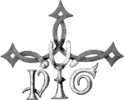Hinckaert knot
| Hinckaert knot |
|---|
| |
| The Hinckaert badge. |
| style="background:#fee8ab;" text-align: center" colspan="3"| Information |
| Family |
Hinckaert family |
| Region |
Netherlands |
| Notes: |
|---|
| Named for Philip Hinckaert, maître d'hôtel to Philip the Handsome in the late 15th century. |
|
The Hinckaert knot, a type of decorative unknot, is a heraldic knot used primarily in Dutch heraldry. It is most notable for its appearance on the Hinckaert family heraldic badge, where a semi-angular form is used as canting arms, a common practice with heraldic badges.
The name "Hinckaert" is delineated as a derivation of hincken, "to limp", in the badge. Hence the center crutch, and the buckle on the knot, implying that it is a strap used to attach the crutch to the leg.[1] The dexter "P" and sinister "G" are traditionally translated as standing for Philip (Hinckaert), with whom the knot originated, and his wife, née Gasparine.[1]
.png)
A portrait of Philip Hinckaert (kneeling). In the background the wall is
diapered in the Hinckaert knot.
References
- ↑ 1.0 1.1 Archaeologia: or, Miscellaneous Tracts Relating to Antiquity. Harvard University: Society of Antiquaries of London. 1887. pp. p. 73 – 74.

.png)